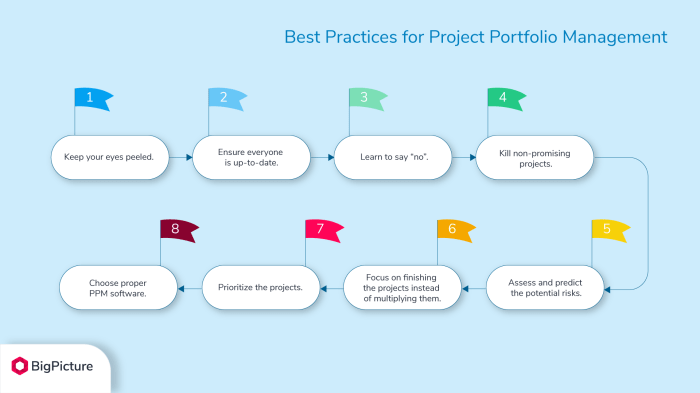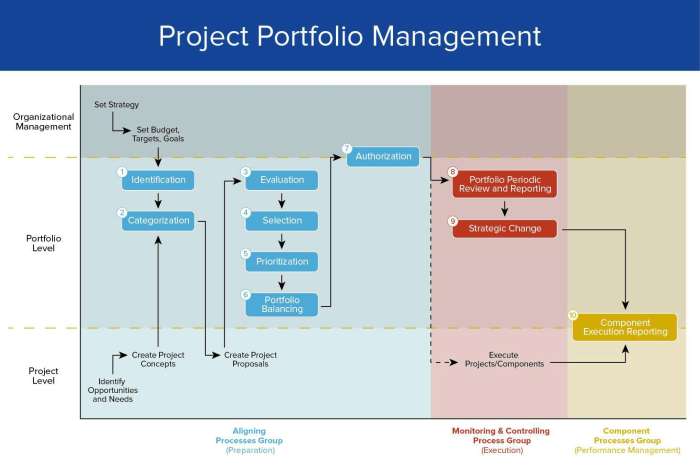
Portfolio Management for Beginners sets the stage for this enthralling narrative, offering readers a glimpse into a story that is rich in detail with casual formal language style and brimming with originality from the outset.
This guide will walk you through the fundamentals of portfolio management, from understanding the concept to practical strategies for effective management.
Introduction to Portfolio Management for Beginners
Portfolio management is the art and science of making decisions about investment mix and policy, matching investments to objectives, asset allocation for individuals and institutions, and balancing risk against performance. It involves selecting and managing an investment mix that aligns with an individual’s goals, risk tolerance, and time horizon.
The Importance of Managing a Portfolio for Beginners
Managing a portfolio is crucial for beginners as it helps in diversifying investments, reducing risk, and maximizing returns. It allows individuals to spread their investments across various asset classes, industries, and regions, which helps in minimizing the impact of volatility in any single investment.
- Portfolio management provides a structured approach to investing, ensuring that beginners have a well-balanced mix of investments that align with their financial goals.
- It helps beginners in understanding their risk tolerance and choosing investments that match their comfort level with volatility.
- By actively managing a portfolio, beginners can take advantage of market opportunities and adjust their investments based on changing market conditions.
“Diversification is the only free lunch in investing.”
Modern Portfolio Theory
The Benefits of Portfolio Management for Individuals Starting Out
- Allows beginners to set clear financial goals and invest accordingly to achieve those goals over time.
- Enables individuals to monitor and track the performance of their investments regularly, making informed decisions based on market trends.
- Helps in building wealth over the long term by optimizing returns and minimizing risks through strategic investment decisions.
Understanding Portfolio Diversification
Portfolio diversification refers to the practice of spreading investments across different asset classes to reduce risk. By not putting all your eggs in one basket, diversification helps to minimize the impact of a decline in any single investment on the overall portfolio.When it comes to building a diversified portfolio, investors can consider a mix of assets such as stocks, bonds, real estate, commodities, and cash equivalents.
Each asset class behaves differently under various market conditions, providing a level of protection against volatility.
Examples of Assets for Portfolio Diversification
- Stocks: Investing in a variety of companies across different industries and regions.
- Bonds: Allocating funds to government bonds, corporate bonds, and municipal bonds.
- Real Estate: Including real estate investment trusts (REITs) or physical properties in the portfolio.
- Commodities: Adding exposure to assets like gold, silver, oil, or agricultural products.
- Cash Equivalents: Holding cash, money market funds, or short-term certificates of deposit.
Diversification is key to managing risk in a portfolio and achieving long-term financial goals.
Strategies for Portfolio Management

Effective portfolio management involves utilizing various strategies to achieve financial goals and minimize risks. One of the key decisions for investors is whether to opt for an active or passive approach in managing their portfolios. Let’s explore the different strategies and tips for beginners to kickstart their portfolio management journey.
Active vs. Passive Portfolio Management
Active portfolio management involves frequent buying and selling of securities in an attempt to outperform the market. Fund managers actively make investment decisions based on market trends, economic conditions, and individual stock analysis. On the other hand, passive portfolio management aims to replicate the performance of a specific market index. This strategy involves minimal trading and typically lower fees compared to active management.
- Active Management:
- Requires continuous monitoring of the market
- Higher fees due to frequent trading
- Potential for higher returns but also higher risks
- Passive Management:
- Low maintenance as it follows a predetermined index
- Lower fees and expenses
- Less risk due to diversified investments
It’s essential for beginners to understand their risk tolerance, investment goals, and time horizon before deciding on an active or passive management approach.
Tips for Beginners in Implementing Portfolio Management Strategies
For beginners looking to venture into portfolio management, here are some tips to consider:
- Set clear investment objectives and risk tolerance levels.
- Diversify your portfolio across different asset classes to reduce risk.
- Regularly review and rebalance your portfolio to ensure alignment with your financial goals.
- Consider seeking advice from financial advisors to make informed decisions.
- Start with small investments and gradually increase exposure as you gain more experience.
Tools and Resources for Portfolio Management

Managing a portfolio effectively requires the use of various tools and resources to make informed decisions and track performance. Technology plays a crucial role in simplifying the process and providing access to real-time data and analysis. There are several online platforms available that can assist beginners in portfolio tracking and analysis.
Essential Tools for Beginners
- Portfolio Management Software: Utilize software that helps in tracking investments, analyzing performance, and monitoring risk.
- Financial News Platforms: Stay updated with the latest news and trends in the financial markets to make informed investment decisions.
- Stock Screeners: Use tools to filter stocks based on specific criteria like market cap, P/E ratio, and dividend yield.
- Risk Management Tools: Implement tools to assess and manage risk in your portfolio effectively.
Role of Technology in Portfolio Management
Technology has revolutionized portfolio management by providing real-time data, advanced analytics, and automation capabilities. It enables investors to make data-driven decisions, optimize their portfolio, and adjust strategies promptly based on market conditions.
Online Platforms for Portfolio Tracking
- Yahoo Finance: Offers a comprehensive platform for tracking portfolios, analyzing stocks, and accessing financial news.
- Google Finance: Provides real-time stock quotes, interactive charts, and portfolio tracking features.
- Bloomberg Professional: A powerful tool for financial professionals offering market data, analytics, and trading solutions.
- Morningstar: Helps in researching investments, analyzing portfolios, and monitoring performance with its wide range of tools.
In conclusion, Portfolio Management for Beginners equips you with the necessary knowledge and tools to kickstart your investment journey with confidence and clarity. Dive into the world of portfolio management and watch your investments grow steadily over time.
FAQ
What is portfolio diversification?
Portfolio diversification involves spreading your investments across various assets to reduce risk.
What are some common strategies for portfolio management?
Common strategies include active and passive management, each with its own approach to managing investments.
How can beginners track their portfolio effectively?
Beginners can utilize online platforms and tools specifically designed for portfolio tracking and analysis.





